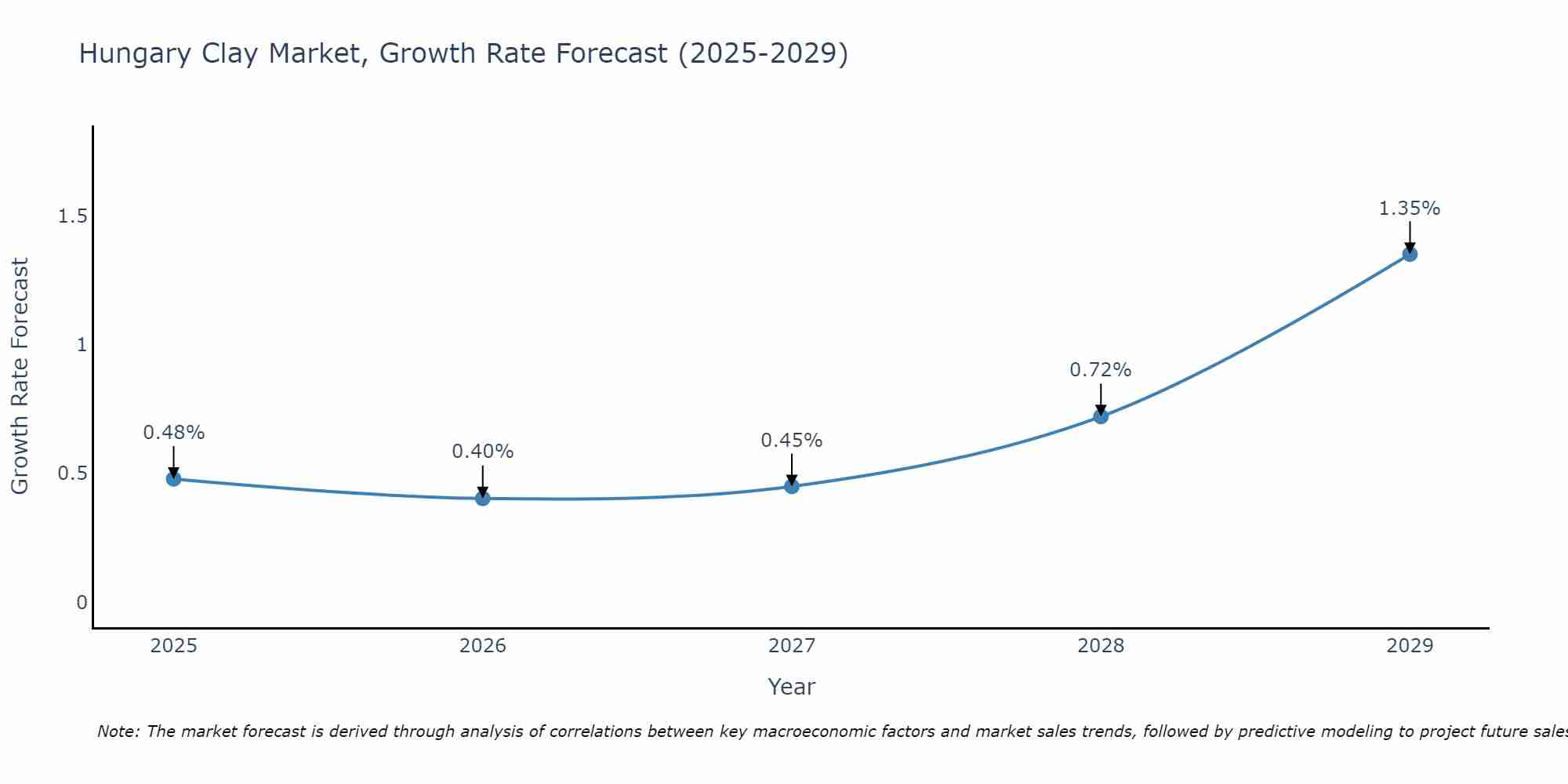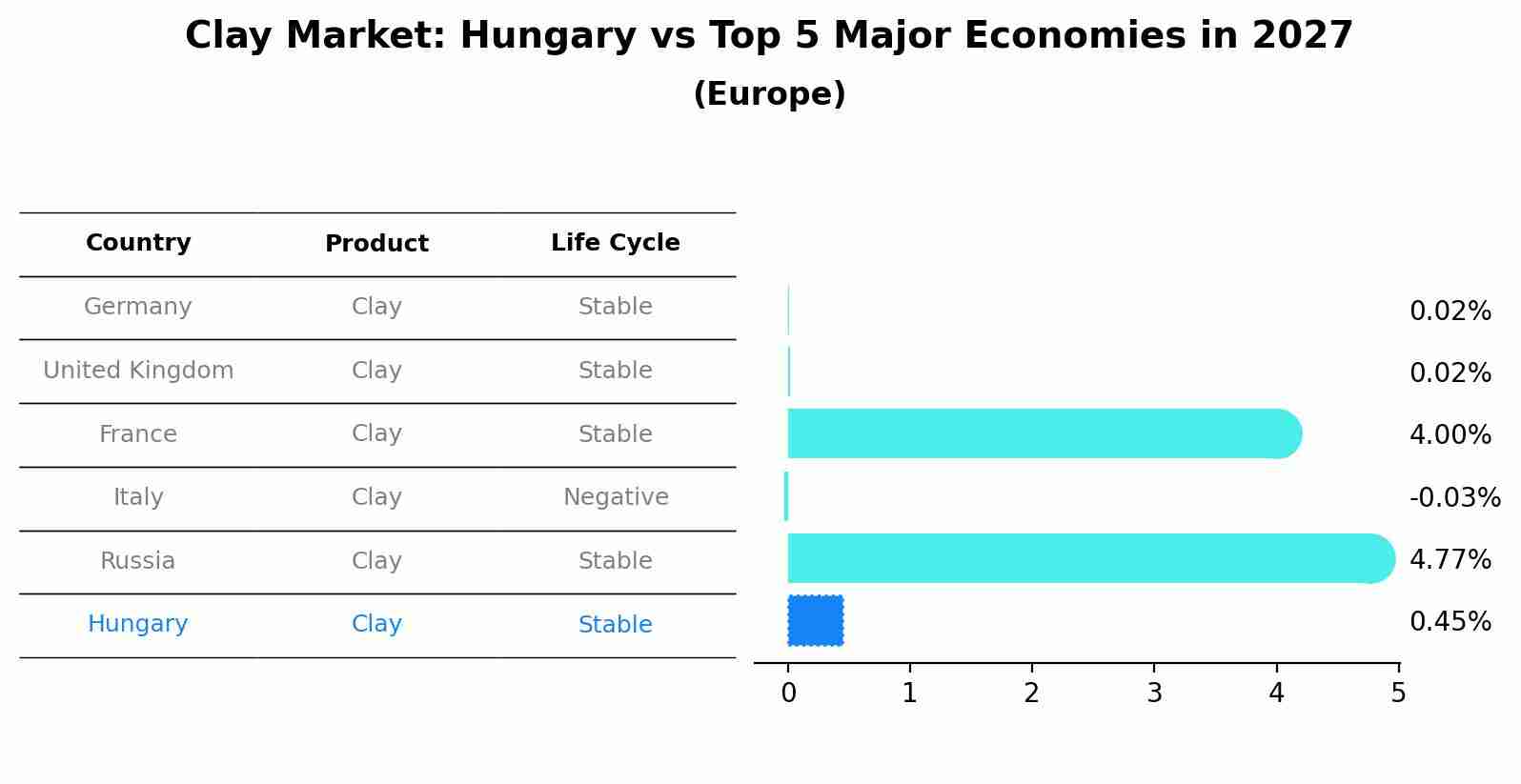Hungary Clay Market Outlook | Companies, Analysis, Growth, Industry, Trends, Share, Size, COVID-19 IMPACT, Forecast, Revenue & Value
| Product Code: ETC318979 | Publication Date: Aug 2022 | Updated Date: Aug 2025 | Product Type: Market Research Report | |
| Publisher: 6Wresearch | No. of Pages: 75 | No. of Figures: 35 | No. of Tables: 20 | |
Hungary Clay Market Size Growth Rate
The Hungary Clay Market is projected to witness mixed growth rate patterns during 2025 to 2029. Commencing at 0.48% in 2025, growth builds up to 1.35% by 2029.

Clay Market: Hungary vs Top 5 Major Economies in 2027 (Europe)
By 2027, the Clay market in Hungary is anticipated to reach a growth rate of 0.45%, as part of an increasingly competitive Europe region, where Germany remains at the forefront, supported by United Kingdom, France, Italy and Russia, driving innovations and market adoption across sectors.

Hungary Clay Market Overview
The clay market in Hungary is characterized by its diverse applications in construction, ceramics, refractories, and other industrial sectors. Hungary rich deposits of clay minerals provide a sustainable source of raw materials for domestic manufacturers, ensuring a steady supply for various industries. With the growing construction activities and infrastructure development in the region, the demand for clay products such as bricks, tiles, and pottery is expected to remain robust.
Drivers of the market
In the clay market, Hungary rich reserves of clay minerals support a diverse range of industries, including construction, ceramics, and manufacturing. The construction sector, in particular, drives the demand for clay-based products such as bricks, tiles, and ceramics, owing to their durability, thermal insulation properties, and aesthetic appeal. Additionally, the growing focus on sustainable construction practices and eco-friendly materials fuels innovation in clay product manufacturing, creating opportunities for market expansion. Furthermore, Hungary strategic location in Central Europe positions it as a key player in the regional clay market, serving both domestic and export markets with high-quality clay products.
Challenges of the market
The Hungary clay market encounters challenges such as environmental regulations, substitution threats, and infrastructure limitations. Clay mining and processing operations may be subject to environmental regulations governing land use, waste disposal, and water management, requiring compliance measures that add complexity and cost to operations. Substitution threats from alternative materials or synthetic products in construction, ceramics, and other clay-consuming industries pose a risk to market demand and pricing stability. Moreover, infrastructure limitations, such as inadequate transportation networks or outdated facilities, can hinder the efficient extraction, processing, and distribution of clay products, affecting market competitiveness and growth potential.
Government Policy of the market
Hungary has seen steady demand from the construction, ceramics, and pottery industries. Government policies have aimed to support sustainable clay extraction practices while regulating environmental impacts. Additionally, investment incentives and infrastructure development projects have aimed to modernize clay mining operations and enhance supply chain efficiency.
Key Highlights of the Report:
- Hungary Clay Market Outlook
- Market Size of Hungary Clay Market, 2021
- Forecast of Hungary Clay Market, 2028
- Historical Data and Forecast of Hungary Clay Revenues & Volume for the Period 2018 - 2028
- Hungary Clay Market Trend Evolution
- Hungary Clay Market Drivers and Challenges
- Hungary Clay Price Trends
- Hungary Clay Porter's Five Forces
- Hungary Clay Industry Life Cycle
- Historical Data and Forecast of Hungary Clay Market Revenues & Volume By Application for the Period 2018 - 2028
- Historical Data and Forecast of Hungary Clay Market Revenues & Volume By Tableware for the Period 2018 - 2028
- Historical Data and Forecast of Hungary Clay Market Revenues & Volume By Sanitary ware for the Period 2018 - 2028
- Historical Data and Forecast of Hungary Clay Market Revenues & Volume By Medical applications for the Period 2018 - 2028
- Historical Data and Forecast of Hungary Clay Market Revenues & Volume By End Use for the Period 2018 - 2028
- Historical Data and Forecast of Hungary Clay Market Revenues & Volume By Ceramic and for the Period 2018 - 2028
- Historical Data and Forecast of Hungary Clay Market Revenues & Volume By Non-ceramic for the Period 2018 - 2028
- Hungary Clay Import Export Trade Statistics
- Market Opportunity Assessment By Application
- Market Opportunity Assessment By End Use
- Hungary Clay Top Companies Market Share
- Hungary Clay Competitive Benchmarking By Technical and Operational Parameters
- Hungary Clay Company Profiles
- Hungary Clay Key Strategic Recommendations
Frequently Asked Questions About the Market Study (FAQs):
1 Executive Summary |
2 Introduction |
2.1 Key Highlights of the Report |
2.2 Report Description |
2.3 Market Scope & Segmentation |
2.4 Research Methodology |
2.5 Assumptions |
3 Hungary Clay Market Overview |
3.1 Hungary Country Macro Economic Indicators |
3.2 Hungary Clay Market Revenues & Volume, 2021 & 2028F |
3.3 Hungary Clay Market - Industry Life Cycle |
3.4 Hungary Clay Market - Porter's Five Forces |
3.5 Hungary Clay Market Revenues & Volume Share, By Application, 2021 & 2028F |
3.6 Hungary Clay Market Revenues & Volume Share, By End Use, 2021 & 2028F |
4 Hungary Clay Market Dynamics |
4.1 Impact Analysis |
4.2 Market Drivers |
4.2.1 Increasing demand for clay in construction and ceramics industries in Hungary |
4.2.2 Growing adoption of clay-based products in the agriculture sector for soil improvement |
4.2.3 Rising awareness about the sustainable and eco-friendly nature of clay products |
4.3 Market Restraints |
4.3.1 Fluctuating prices of raw materials used in clay production |
4.3.2 Environmental regulations impacting clay extraction and processing |
4.3.3 Competition from alternative materials like polymers and composites |
5 Hungary Clay Market Trends |
6 Hungary Clay Market, By Types |
6.1 Hungary Clay Market, By Application |
6.1.1 Overview and Analysis |
6.1.2 Hungary Clay Market Revenues & Volume, By Application, 2018 - 2028F |
6.1.3 Hungary Clay Market Revenues & Volume, By Tableware, 2018 - 2028F |
6.1.4 Hungary Clay Market Revenues & Volume, By Sanitary ware, 2018 - 2028F |
6.1.5 Hungary Clay Market Revenues & Volume, By Medical applications, 2018 - 2028F |
6.2 Hungary Clay Market, By End Use |
6.2.1 Overview and Analysis |
6.2.2 Hungary Clay Market Revenues & Volume, By Ceramic and, 2018 - 2028F |
6.2.3 Hungary Clay Market Revenues & Volume, By Non-ceramic, 2018 - 2028F |
7 Hungary Clay Market Import-Export Trade Statistics |
7.1 Hungary Clay Market Export to Major Countries |
7.2 Hungary Clay Market Imports from Major Countries |
8 Hungary Clay Market Key Performance Indicators |
8.1 Percentage of clay products with eco-friendly certifications |
8.2 Number of new applications of clay-based products in different industries |
8.3 Rate of adoption of clay products in construction projects |
8.4 Research and development investment in clay product innovation |
8.5 Customer satisfaction levels with clay product performance and quality |
9 Hungary Clay Market - Opportunity Assessment |
9.1 Hungary Clay Market Opportunity Assessment, By Application, 2021 & 2028F |
9.2 Hungary Clay Market Opportunity Assessment, By End Use, 2021 & 2028F |
10 Hungary Clay Market - Competitive Landscape |
10.1 Hungary Clay Market Revenue Share, By Companies, 2021 |
10.2 Hungary Clay Market Competitive Benchmarking, By Operating and Technical Parameters |
11 Company Profiles |
12 Recommendations |
13 Disclaimer |
- Single User License$ 1,995
- Department License$ 2,400
- Site License$ 3,120
- Global License$ 3,795
Search
Related Reports
- ASEAN Bearings Market (2025-2031) | Strategy, Consumer Insights, Analysis, Investment Trends, Opportunities, Growth, Size, Share, Industry, Revenue, Segments, Value, Segmentation, Supply, Forecast, Restraints, Outlook, Competition, Drivers, Trends, Demand, Pricing Analysis, Competitive, Strategic Insights, Companies, Challenges
- Europe Flooring Market (2025-2031) | Outlook, Share, Industry, Trends, Forecast, Companies, Revenue, Size, Analysis, Growth & Value
- Saudi Arabia Manlift Market (2025-2031) | Outlook, Size, Growth, Trends, Companies, Industry, Revenue, Value, Share, Forecast & Analysis
- Uganda Excavator, Crane, and Wheel Loaders Market (2025-2031) | Strategy, Consumer Insights, Analysis, Investment Trends, Opportunities, Growth, Size, Share, Industry, Revenue, Segments, Value, Segmentation, Supply, Forecast, Restraints, Outlook, Competition, Drivers, Trends, Demand, Pricing Analysis, Competitive, Strategic Insights, Companies, Challenges
- Rwanda Excavator, Crane, and Wheel Loaders Market (2025-2031) | Strategy, Consumer Insights, Analysis, Investment Trends, Opportunities, Growth, Size, Share, Industry, Revenue, Segments, Value, Segmentation, Supply, Forecast, Restraints, Outlook, Competition, Drivers, Trends, Demand, Pricing Analysis, Competitive, Strategic Insights, Companies, Challenges
- Kenya Excavator, Crane, and Wheel Loaders Market (2025-2031) | Strategy, Consumer Insights, Analysis, Investment Trends, Opportunities, Growth, Size, Share, Industry, Revenue, Segments, Value, Segmentation, Supply, Forecast, Restraints, Outlook, Competition, Drivers, Trends, Demand, Pricing Analysis, Competitive, Strategic Insights, Companies, Challenges
- Angola Excavator, Crane, and Wheel Loaders Market (2025-2031) | Strategy, Consumer Insights, Analysis, Investment Trends, Opportunities, Growth, Size, Share, Industry, Revenue, Segments, Value, Segmentation, Supply, Forecast, Restraints, Outlook, Competition, Drivers, Trends, Demand, Pricing Analysis, Competitive, Strategic Insights, Companies, Challenges
- Israel Intelligent Transport System Market (2025-2031) | Strategy, Consumer Insights, Analysis, Investment Trends, Opportunities, Growth, Size, Share, Industry, Revenue, Segments, Value, Segmentation, Supply, Forecast, Restraints, Outlook, Competition, Drivers, Trends, Demand, Pricing Analysis, Competitive, Strategic Insights, Companies, Challenges
- Uganda Precast and Aggregate Market (2025-2031) | Strategy, Consumer Insights, Analysis, Investment Trends, Opportunities, Growth, Size, Share, Industry, Revenue, Segments, Value, Segmentation, Supply, Forecast, Restraints, Outlook, Competition, Drivers, Trends, Demand, Pricing Analysis, Competitive, Strategic Insights, Companies, Challenges
- Australia IT Asset Disposal Market (2025-2031) | Strategy, Consumer Insights, Analysis, Investment Trends, Opportunities, Growth, Size, Share, Industry, Revenue, Segments, Value, Segmentation, Supply, Forecast, Restraints, Outlook, Competition, Drivers, Trends, Demand, Pricing Analysis, Competitive, Strategic Insights, Companies, Challenges
Industry Events and Analyst Meet
Our Clients
Whitepaper
- Middle East & Africa Commercial Security Market Click here to view more.
- Middle East & Africa Fire Safety Systems & Equipment Market Click here to view more.
- GCC Drone Market Click here to view more.
- Middle East Lighting Fixture Market Click here to view more.
- GCC Physical & Perimeter Security Market Click here to view more.
6WResearch In News
- Doha a strategic location for EV manufacturing hub: IPA Qatar
- Demand for luxury TVs surging in the GCC, says Samsung
- Empowering Growth: The Thriving Journey of Bangladesh’s Cable Industry
- Demand for luxury TVs surging in the GCC, says Samsung
- Video call with a traditional healer? Once unthinkable, it’s now common in South Africa
- Intelligent Buildings To Smooth GCC’s Path To Net Zero













